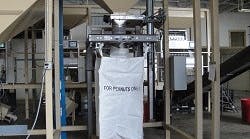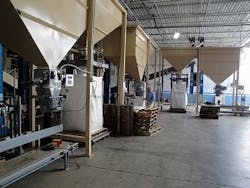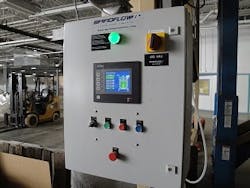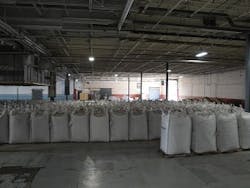From manual to automated: How a bulk bag filler saved time and increased productivity for one plant
He found that there was some demand for fresh, raw peanuts. As the field crew harvested the crop, people would stop and ask to buy a bucket of peanuts from the harvest wagon. He started selling by the bucket for $5 each. To meet the demand, he purchased 5-lb bags and set up a roadside stand.
Business was steady but not a large enough outlet for the volume of peanuts he was growing — up to 10,000 tons.
In 2007, Swinson founded Golden Grove, when he purchased the Mt. Olive Candy assets. The move toward value-added product lines led to three distinct peanut products: peanut candy, packaged salted in-shell peanuts, and bulk raw in-shell peanuts.
At the same time Swinson built a wholesale business to market on the majority of the annual 10,000-ton harvest by providing raw in-shell peanuts. Golden Grove peanuts are harvested, packed in 900 lb bulk bags and shipped to customers around the world. As the wholesale business grew, he saw clear opportunities to improve efficiency.
Golden Grove employees were filling 20 bulk bags each day by hand. They had three filling stations set up in their warehouse, each containing a hopper filled with in-shell peanuts. A slide gate was installed at the bottom of each hopper and a scale was positioned below. Each filling station was manned by three workers who would place an empty bulk bag on the scale and beneath the hopper. An operator would open the slide gate, allowing the peanuts to fall into the bulk bag and wait until the bag was within 2 lb of the target 900 lb weight.
As the wholesale business grew Swinson recognized that the manual filling process in place didn’t meet his efficiency standards. The process was extremely slow with a top filling rate of 20 bulk bags per day and quite labor-intensive with nine employees working full-time. Weighing accuracies of +/- 2 lb could be improved to increase profitability, as well.
Swinson needed a significantly faster filling system to meet the growing wholesale demand. The company turned to Spiroflow Systems, which recommended an automated gain-in-weight filling system utilizing the C1-2 bulk bag filler with a control panel.
“Our local representative, CW Garner, informed me that Golden Grove was interested in purchasing a bulk bag filler for his Warsaw, North Carolina, operation,” explains Mathias Lee, vice president of sales and marketing at Spiroflow Systems. “CW and I had a few brief conversations regarding Lee’s process. I prepared a proposal, and CW and I visited with Lee the same week. I assessed the site during our visit with Lee and answered many questions that Mr. Swinson had about the unit. Before we departed Golden Grove that same day, Lee signed the quote and ordered the first unit. The other units followed quickly — within a year — once the first unit was performance-proven.”
- A large elevator conveyor is installed behind each hopper to continually deliver salted in-shell peanuts to a hopper.
- The bottom of each hopper is fitted with a 10-in. slide gate valve operated by the control panel.
- Spiroflow Systems C1-2 bulk bag fillers are installed under each hopper.
- The bulk bag fillers are designed to fill customer-specified 40-in. square bulk bags. The filler height can be adjusted to accommodate bags that are 50-to-64-in. tall with corner loops 8-to-10-in. long.
- All product contact parts on the fillers are constructed from 304 stainless steel to meet food safety standards.
- A flexible connection is installed between the filling head of each bulk bag filler and the base of each hopper. Flexible connections are strongly recommended in a weighing application as rigid connections would interfere with accurate weighing.
- A flexible connection is installed between the bag inflation fan and the filling head of each bulk bag filler.
- Load cells on the bulk bag filler are connected to a Spiroflow Systems NEMA 4-certified control panel with digital weigh batch controls, slide gate valve position control, and bag inflation blower fan.
With the installation of three Spiroflow C1-2 bulk bag fillers with gain-in-weight controls, Golden Grove now has a single operator assigned to the filling area and the company fills 300 bulk bags per day. The filling process is as follows:
- An operator places a pallet and slip sheet on the bulk bag filler.
- An operator installs an empty bulk bag on to the bulk bag filler attaching each of four bag loops on to the quick release bag clips.
- The operator attaches the bag spout to the inflatable neck seal and inflates the neck seal so that it firmly holds the bag spout in place during filling.
- From the control panel the operator inflates the bulk bag with clean dry air.
- From the control panel the operator starts the filling process and the bag is filled within 0.5 lb.
- From the control panel the operator deflates the neck seal and engages the automatic bag loop release.
- The bulk bag is removed by forklift.
It only takes about 10 min to fill each bulk bag. The new bulk bag filling system delivers the speed that Golden Grove needed to meet its growing wholesale business demands.
“The majority of Golden Grove’s equipment is brand-new and state-of-the-art; automation is key in building sustainable business,” attests Lee.
“Spiroflow is always willing to work with us,” says Swinson. “A Spiroflow Systems controls engineer worked on-site to program the control panels, which was well worth the investment.’ Additionally Golden Grove has significantly increased productivity by reducing the number of required operators from nine to one. Weighing accuracy has increased by more than 400%, and product spillage was reduced. The automated filling system has eliminated any operator contact with the product virtually eliminating product contamination. “The Spiroflow solution delivered the filling speed we needed and more,” says Swinson. “We are constantly trying to find new ways to add value to our crops and make our farm as efficient as possible. My dad always said, ‘If you don't keep up, eventually you will be left behind.’”




